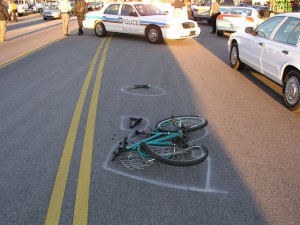For pedestrian accidents, we gather evidence from the scene, photos and vehicle. We want to determine what part of the vehicle struck the pedestrian and the location of the pedestrian when they were struck. We also seek to determine where the pedestrian and vehicle came to rest. We use this information to determine the speed of the vehicle and relative positions of the vehicle and pedestrian at impact. If a pedestrian walks or runs into the roadway, we also need to determine their initial location. If a traffic signal was present, we gather information about the traffic signal timing. Although in backing accidents the physical evidence is limited, we can still get useful information from inspecting the scene and vehicle. Statements from the driver and witnesses are usually very important.
For bicycle accidents, we gather evidence from the scene, photos, vehicle and bicycle. We want to determine what part of the vehicle struck the bicycle and the location of the bicycle when it was struck. We also need to determine where the rider, bicycle and vehicle came to rest. We use this information to determine the speed of the vehicle and relative positions of the vehicle and bicycle at impact.
Areas we typically address for a pedestrian or bicycle accident:
- The location of the pedestrian when they were struck by the vehicle
- The type of damage the pedestrian caused to the vehicle for use in determining the speed of the vehicle
- Whether there was sufficient reaction time for the driver to avoid the pedestrian
- The speed of the vehicle and sometimes the speed of the bicycle
- The visibility of the rider and bicycle to the driver and the visibility of the vehicle to the rider
- The timing and positions of the vehicle and bicycle during the accident sequence
- Whether the driver and rider were following rules of the road applicable to them
- When the driver first became aware of the rider and bicycle
- Whether traffic signal timing had a role in the accident
- Whether the accident was avoidable

